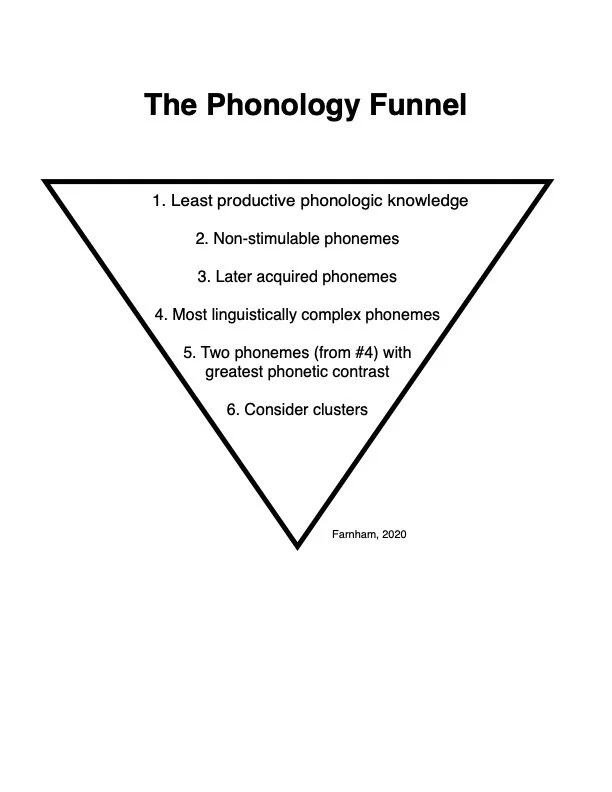Questions SLPs Ask About Complexity Treatment
Focus on BIG IDEAS
What does a session look like?
There are 4 main activities in each session that target four big ideas underlying successful therapy:
developing stimulability for all phonemes
developing phonologic awareness
practicing maximal contrast pairs
practicing high frequency words containing phonemic targets
These concepts can be taught in a variety a ways, but should each be incorporated into every session in some form.
Phoneme Selection Funnel
WHAT IS different about the complexity approach to Speech Sound disorders?
Gierut’s research examined target selection and its effect on the efficiency of therapy for speech sounds. Her research demonstrated that the following types of targets should be selected first:
later developing sounds
more complex sounds
clusters (under certain conditions)
sounds that are completely absent from the child’s system rather than those that are present, but inconsistent
at least 2 targets that are maximally different from each other in place, voice, manner, and major sound class
These conclusions are the opposite of what has been implemented in traditional therapy, but have been shown in multiple studies and in clinical practice to facilitate rapid generalization to multiple sounds and sound classes.
The Phoneme Selection Funnel (left) is the step-by-step process that can be used to help in target selection.
Maximal Contrast Pairs
Once I’ve found the phonemes the child knows the least about, how do I pick Just two targets?
Review the potential targets, ideally late-developing phonemes which the child does not have in their system, and for which they are not stimulable. From the phonemes that meet these criteria, find the 2 that are the most different from each other, looking for 2 phonemes that are produced at a different anatomical location (place), in a different manner (such as stop, fricative, glide, affricate). and have different voicing (one voiced, one unvoiced). They should also contrast in sound class - an obstruent versus a sonorant.
Given the unique nature of children’s error patterns, it may not always be possible to select 2 targets that are different in all 4 characteristics. If that is not possible, select the two phonemes that have the greatest number of differences between them. In clinical experience, I have found that voicing is the least important contrast, but place is very important.If the targets are too similar in place, there is not sufficient contrast to teach the child how to produce 2 distinct sounds. Gierut’s research also indicates that major sound class may be the most important distinction.
When has the child hit the target?
How long should I continue working on the original target phonemes? When do I move on to different Targets? What is mastery in this approach?
These are the most frequently asked questions, and they are all related to the question of mastery. In traditional therapy, mastery means 90-100% correct production of the sound at increasing levels of perceived difficult: isolation, syllables, all three positions in words, phrases, sentences and conversation. Since this approach is not focused on mastery of the motor skills necessary to produce the sounds, but rather on changing the child’s phonological system, different criteria are applied.
The initial targets are very difficult - not stimulable, late developing, highly complex - so the expectation is that they will take a long time to develop even at the imitation level, possibly as long as 8 - 10 weeks. However, during that 8-10 weeks, the child is learning about multiple features of sounds - place, voice, manner, major sound class - because of the high degree of contrast between the targets. As a result, even though the selected targets themselves may not be improving, other sounds in the child’s system are beginning to fall into place without direct treatment. The result is a rising tide of intelligibility across the child’s sound system.
In clinical practice, it is time to move to a new target when the child can consistently imitate a target fluently in words. If only one of the selected targets has reached this level, replace that target with a new target that is maximally different from the unmastered target. If both targets have reached imitation fluency, the select 2 new maximally different targets. At that point in the therapy process, you will likely be looking for new targets fairly often, because the child is rapidly moving toward an accurate phonologic system!




